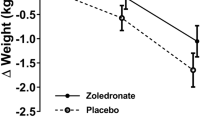Abstract
Recent preclinical studies suggest that osteoblasts are able to induce testosterone production by the testis, a process mediated by osteocalcin. Bisphosphonates substantially reduce osteocalcin levels. If osteocalcin is an important regulator of testosterone levels in adult men, it would be expected that the substantial reductions in osteocalcin induced by zoledronate would impact negatively on testosterone levels. Previously, we carried out a 2-year randomized, controlled trial of annual 4 mg zoledronate in 43 HIV-infected men. To explore the relationship between osteocalcin and testosterone further, we measured serum testosterone at baseline, 3 months, and 2 years; luteinizing hormone at 3 months and 2 years; and total osteocalcin at 2 years in 28 trial participants with available blood samples. At 2 years, total osteocalcin was 39 % lower in the zoledronate group than the placebo group (zoledronate mean 10.1 [SD 3.0] μg/L, placebo 16.5 [SD 4.9] μg/L, P = 0.003). Despite these substantial differences in osteocalcin levels, testosterone levels did not change over time in either group and there were no between-group differences over time, P = 0.4 (mean change at 2 years [adjusted for baseline levels] in zoledronate group −0.4 nmol/L, 95 % CI −2.5 to 1.6; placebo group 0.4 nmol/L, 95 % CI −1.6 to 2.5). Luteinizing hormone was within the normal range and did not differ between the groups at either 3 months or 2 years. Thus, the absence of a change in testosterone despite a substantial reduction in osteocalcin following zoledronate treatment argues against a biologically significant role for osteocalcin in the regulation of testosterone in adult men. This provides reassurance that men receiving potent antiresorptive drugs are not at risk of iatrogenic hypogonadism.

Similar content being viewed by others
References
Oury F, Sumara G, Sumara O, Ferron M, Chang H, Smith CE, Hermo L, Suarez S, Roth BL, Ducy P, Karsenty G (2011) Endocrine regulation of male fertility by the skeleton. Cell 144:796–809
Kirmani S, Atkinson EJ, Melton LJ 3rd, Riggs BL, Amin S, Khosla S (2011) Relationship of testosterone and osteocalcin levels during growth. J Bone Miner Res 26:2212–2216
Kanazawa I, Tanaka K, Ogawa N, Yamauchi M, Yamaguchi T, Sugimoto T (2013) Undercarboxylated osteocalcin is positively associated with free testosterone in male patients with type 2 diabetes mellitus. Osteoporos Int 24:1115–1119
Reid IR, Brown JP, Burckhardt P, Horowitz Z, Richardson P, Trechsel U, Widmer A, Devogelaer JP, Kaufman JM, Jaeger P, Body JJ, Brandi ML, Broell J, Di Micco R, Genazzani AR, Felsenberg D, Happ J, Hooper MJ, Ittner J, Leb G, Mallmin H, Murray T, Ortolani S, Rubinacci A, Saaf M, Samsioe G, Verbruggen L, Meunier PJ (2002) Intravenous zoledronic acid in postmenopausal women with low bone mineral density. N Engl J Med 346:653–661
Bolland MJ, Grey AB, Horne AM, Briggs SE, Thomas MG, Ellis-Pegler RB, Woodhouse AF, Gamble GD, Reid IR (2007) Annual zoledronate increases bone density in highly active antiretroviral therapy–treated human immunodeficiency virus–infected men: a randomized controlled trial. J Clin Endocrinol Metab 92:1283–1288
Bolland MJ, Grey AB, Horne AM, Briggs SE, Thomas MG, Ellis-Pegler RB, Callon KE, Gamble GD, Reid IR (2008) Effects of intravenous zoledronate on bone turnover and BMD persist for at least 24 months. J Bone Miner Res 23:1304–1308
Reid IR (2002) Relationships among body mass, its components, and bone. Bone 31:547–555
Lee NK, Sowa H, Hinoi E, Ferron M, Ahn JD, Confavreux C, Dacquin R, Mee PJ, McKee MD, Jung DY, Zhang Z, Kim JK, Mauvais-Jarvis F, Ducy P, Karsenty G (2007) Endocrine regulation of energy metabolism by the skeleton. Cell 130:456–469
Pittas AG, Harris SS, Eliades M, Stark P, Dawson-Hughes B (2009) Association between serum osteocalcin and markers of metabolic phenotype. J Clin Endocrinol Metab 94:827–832
Kindblom JM, Ohlsson C, Ljunggren O, Karlsson MK, Tivesten A, Smith U, Mellstrom D (2009) Plasma osteocalcin is inversely related to fat mass and plasma glucose in elderly Swedish men. J Bone Miner Res 24:785–791
Schwartz AV, Schafer AL, Grey A, Vittinghoff E, Palermo L, Lui LY, Wallace RB, Cummings SR, Black DM, Bauer DC, Reid IR (2013) Effects of antiresorptive therapies on glucose metabolism: results from the FIT, HORIZON-PFT and FREEDOM trials. J Bone Miner Res. doi:10.1002/jbmr.1865
Schafer AL, Sellmeyer DE, Schwartz AV, Rosen CJ, Vittinghoff E, Palermo L, Bilezikian JP, Shoback DM, Black DM (2011) Change in undercarboxylated osteocalcin is associated with changes in body weight, fat mass, and adiponectin: parathyroid hormone (1–84) or alendronate therapy in postmenopausal women with osteoporosis (the PaTH study). J Clin Endocrinol Metab 96:E1982–E1989
Kasukawa Y, Miyakoshi N, Ebina T, Aizawa T, Shimada Y (2012) Effects of bisphosphonate alone or combined treatment of bisphosphonate and vitamin K2 on serum undercarboxylated osteocalcin or osteocalcin in osteoporotic women. J Bone Miner Res 27(Suppl 1):SA0371
Acknowledgement
This study was funded by the Health Research Council of New Zealand.
Author information
Authors and Affiliations
Corresponding author
Additional information
I Reid has received research funding, speaker and consultancy fees from Novartis, Merck, Procter & Gamble, and Amgen. All the other authors have stated that they have no conflict of interest.
Rights and permissions
About this article
Cite this article
Bolland, M.J., Grey, A., Horne, A.M. et al. Testosterone Levels Following Decreases in Serum Osteocalcin. Calcif Tissue Int 93, 133–136 (2013). https://doi.org/10.1007/s00223-013-9730-x
Received:
Accepted:
Published:
Issue Date:
DOI: https://doi.org/10.1007/s00223-013-9730-x




